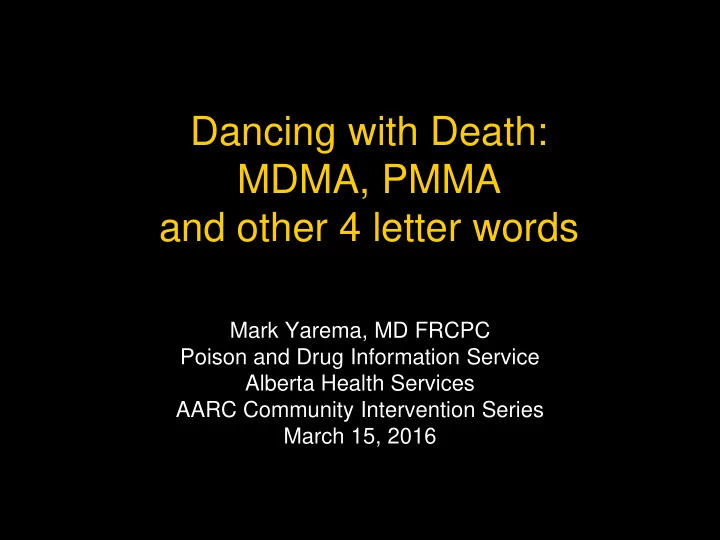

Dancing with Death: MDMA, PMMA and other 4 letter words Mark Yarema, MD FRCPC Poison and Drug Information Service Alberta Health Services AARC Community Intervention Series March 15, 2016
Objectives • At the conclusion of this presentation, participants should be able to: – Appreciate the structural similarity between MDMA, PMMA and other amphetamines – Compare and contrast the clinical features of acute toxicity from MDMA, PMMA and other amphetamines – Describe the management of toxicity from MDMA, PMMA and other amphetamines
Outline • Case presentation • Background • Pharmacology • Pathophysiology • Clinical features • Management • Summary
Case • 16 y.o. male at house party • Overnight: ingested “8 Ecstasy pills” • Not seen for several hours • Next day: walking outside house, bizarre behavior unconscious, unresponsive • Paramedics arrive: cardiac arrest X 1 en route to hospital successfully resuscitated
Hospital course • Arrives in ED ~ 1330 hours: – temp 43 o C, GCS 3, sweaty, rigid – arrests again resuscitated • Labs 1400 hours: – K 9.6, lactate 3.7, CK 731, Creat 141, ALT 57, Tnt 0.03 • Treatment: – admitted to ICU – sedated and paralyzed – cooling blankets, ice, cooling catheter
Hospital course • Temperature normalized after 12 hours of active cooling • Develops: – Rhabdomyolysis – Kidney and liver failure – Cerebral edema • Died 4 days after admission
Comprehensive urine drug screen results • Cannabinoids • Amphetamine • Methamphetamine • MDMA • PMA • PMMA
Background
MDMA • 3,4-methylenedioxymethamphetamine • 1912 - first synthesized by Merck • 1914 - marketed as appetite suppressant • 1970’s/80’s - prescribed by psychotherapists to help patients “search within themselves” • 1980’s – popularity at raves increases • Street names: “Ecstasy”, “X”, “E”, “Adam”, “Molly”, “XTC”, “M&M”, “MDM”, “rolls”, “beans”
PMMA/PMA • PMMA: Paramethoxymethamphetamine • PMA: Paramethoxyamphetamine • 1973 – PMA fatalities in Ontario • 2011/12 – PMMA fatalities in AB and BC • Street names: “Chicken Fever”, “Killer”, “Double stacked”, “Mitsubishi turbo”, “Red Mitsubishi”, “Death”, “Dr. Death”
Locations of PMMA fatalities worldwide
Pure Ecstasy? MDMA: • MDMA ● caffeine • MDA ● lidocaine 0 - 250 mg per tab • MDEA ● procaine • MBDB ● ketamine • mephedrone ● DXM • 2C-B ● DOB • atropine ● PMA • methamphetamine ● PMMA • PCP ● cocaine • pseudoephedrine Togni et al. J For Sci 2015; 60: 147-151 Morefield et al. Addiction 2011: 106:1293-1300 Vogels et al. Addiction 2009; 104: 2057-2066
Pharmacology
Structural similarities Methamphetamine Amphetamine MDMA MDA PMMA PMA
MDMA: mechanisms of action • Major: – release of norepinephrine and serotonin from presynaptic terminals • Minor: – release of dopamine from presynaptic terminals – inhibit reuptake of catecholamines via competitive inhibition – monoamine oxidase inhibition
synthesis breakdown reuptake release agonism Goldfrank’s Toxicologic Emergencies, 9 th ed, 2011, page 195
Pathophysiology
Epstein et al. Scand J Med Exer Sport 2011;21:742-8.
MDMA and heat generation • Multifactorial – Drug dose • “the dose makes the poison” – Genetics • ? Ryanodine receptor dysfunction • ? Poor 2D6 metabolism – Hydration status • Activity, fluid consumption – Environment • Dance club, house, rave (“chill out room”), ambient temperature Parrott et al. Drug Alc Dep 2012;121:1-9
MDMA clinical features
Acute clinical features • Serotonergic • Sympathomimetic • Dopaminergic
Serotonin Syndrome Clinical Triad • Cognitive Changes – Altered mental status, elevated mood • Autonomic Instability – Hyperthermia, high or low BP, tachycardia, mydriasis • Neuromuscular Abnormalities – Clonus (spontaneous or inducible, wrist/ankles/eyes), hyperreflexia, rigid extremities, shivering, startling
Boyer et al, NEJM 2005;352:1112-20.
Sympathomimetic toxidrome • Vitals: tachycardia, hypertension, hyperthermia • Mental status: agitated • Pupils: mydriasis • Skin: diaphoretic • Bowel sounds: normal or increased • Misc: tremor, seizures
Dopaminergic effects • Psychosis • Choreoathetotic movements
PMMA toxicity • Compared to MDMA: – Delayed onset of symptoms – Higher incidence of seizures and dysrhythmias – Hypoglycemia (reasons unclear) – ? Sodium channel blockade wide QRS
AB and BC PMMA fatalities 2011-12 Characteristic Result (N=27) Median age, years 24 (range 14-52) History of drug use, no. (%) 12 (44) Time from exposure to death, hours 17 (5-264) Median temperature on presentation, 39.4 (34-43.8) o C Substances other than PMMA found in MDMA (27), cocaine (14), patient at death methamphetamine (12) Location of exposure Home (13), house party (9), bar/concert (5) Nicol et al. CMAJ Open 2015;3(1):E83-90.
Management
ABCDEFG’s of toxicology • A irway • B reathing • C irculation • D econtamination • E limination • F ind an antidote • G eneral management
Hyperthermia management • Goal: core temp. < 39 degrees C – Benzodiazepines for agitation and shivering – Ice packs – Cooling blankets – Intubate, sedate and paralyze – Cooled IV Fluids (at 4°C) – Intravascular Cooling Devices – Specific antidotes • cyproheptadine, dantrolene
Cool it! Pease et al. Int Care Med 2009;35:1454-1458.
Prognosis • Predictors of outcome: – Degree and duration of temperature elevation – Longer time to initiation of cooling measures – Multiorgan dysfunction (anuria, coma, CV failure) • Serial exams and serial imaging important
Take home points • Variable content of street drugs • Structural similarity between MDMA and PMMA results in similar clinical effects • Clinical triad: adrenergic, serotonergic, and dopaminergic effects • Rapid cooling and control of agitation mainstays of treatment • Prognosis related to degree and duration of hyperthermia
Recommend
More recommend